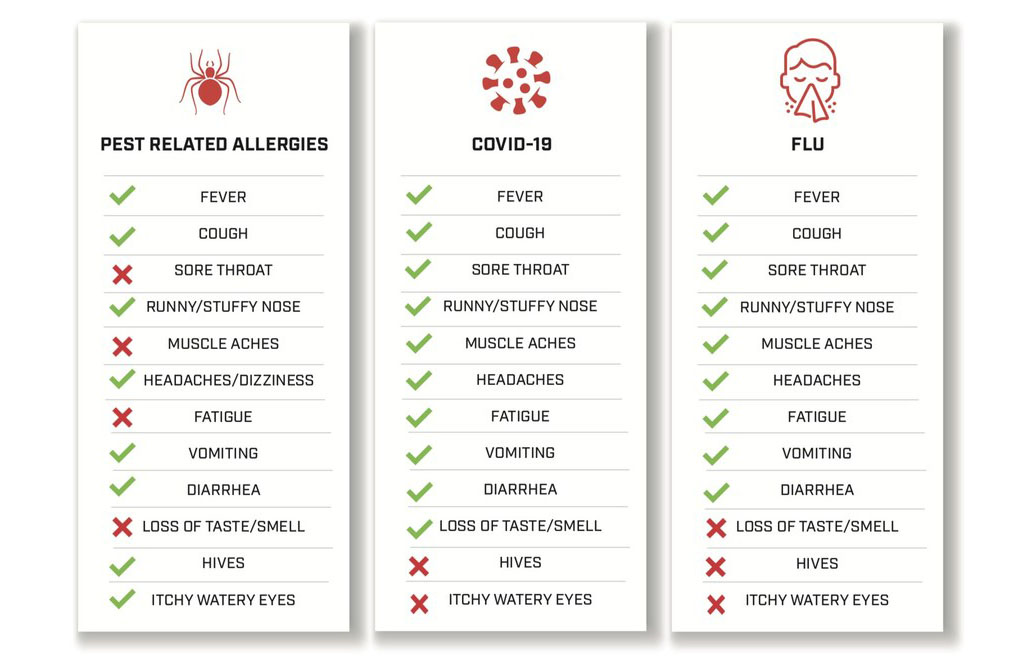 Nashville, TN – Pest allergies caused by stinkbugs and ladybugs overwintering in your home may cause similar symptoms to COVID-19 Coronavirus, the flu and the common cold.
Nashville, TN – Pest allergies caused by stinkbugs and ladybugs overwintering in your home may cause similar symptoms to COVID-19 Coronavirus, the flu and the common cold.
Moving into the cooler months and influenza season of 2020 is causing Americans to worry that it will be difficult to determine what disease or reaction they are having. COVID-19 Coronavirus, the flu, a common cold and pest allergies share a lot of similar symptoms.

Without a few key indicators or a test, you may not know for sure which one it is.
The main difference, between COVID-19 Coronavirus and the flu, is the loss of smell and taste.
Losing this sensation is one of the many wacky symptoms that can accompany the COVID-19 Coronavirus infection. This medical phenomenon is called anosmia.
Dealing with invasive pests in the fall months can not only cause an annoying distraction with crawling insects all over your ceiling, but can also cause some alarming allergic reactions that mimic the flu and COVID-19 Coronavirus. After pest allergies progress, the later stage symptoms do not develop into the same alarming signs as the flu or COVID-19 Coronavirus.
Symptoms of Pest Allergies
Below is a short list of some symptoms caused by pests and pest infestations in structures and homes, according to the Asthma and Allergy Foundation of America:
- Skin rashes, itching or hives
- Swelling of the lips, tongue or throat
- Shortness of breath, trouble breathing or wheezing (whistling sound during breathing)
- Dizziness and/or fainting
- Stomach pain, vomiting, bloating or diarrhea
- Feeling like something awful is about to happen
Ladybug and Stink Bug common allergic reactions
Ladybugs and Stinkbugs are looking for wintering areas in the voids of homes. They can enter homes and buildings by the hundreds and thousands. In fact, this could not only cause only a nuisance, but a health issue due to allergic reactions. Fleas are just as treacherous. Fleas can come from any pet, rodent or wildlife around your dwelling.
Stink bugs and ladybugs do not bite in order to transmit disease, however, both do cause allergic reactions. Most noteworthy, they have the ability to mimic some of the flu or COVID-19 Coronavirus symptoms. These symptoms include fever, cough, runny nose, headache and even vomiting or diarrhea. To add, some of the allergic reactions that is a tell-tell sign to distinguish from COVID-19 Coronavirus and the flu are the following:
- Itchy and watery eyes
- Hives
For example, hives look like raised irregular shaped spots on your skin and sometimes appear red and swollen around the area.
Also, itchy & watery eyes are typical in allergies to pests. These symptoms are just two of the tell-tell signs of an allergic reaction.
Control and Prevention of Stink Bugs, Ladybugs
Areas you will find stink bugs, ladybugs are almost limitless, but a few key areas to look are the following:
- Under beds
- Beneath the Sofas
- Crown molding cracks and surfaces
- Window trim
- Attics
- Bookcases
- Behind curtains
There are lots of ways to keep stink bugs and ladybugs out of your home.
A few simple ticks are the following:
- Caulk windows inside and out
- Weather strip entry doors
- Secure crawlspace doors and entries
- Caulk small gaps around pipe entry points from outside or under your home
- Cap or screen your chimney
- Hire U.S. Pest to treat the outside of your home’s perimeter as well as cracks and crevices where stinkbugs are entering or harboring.
Use the infographic above to have a quick reference for any symptoms you may be having. Furthermore, always call your doctor or seek medical attention if you are experiencing a medical emergency or trouble breathing



